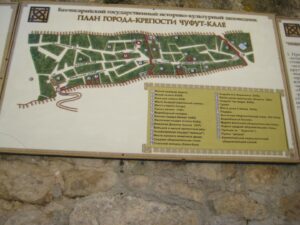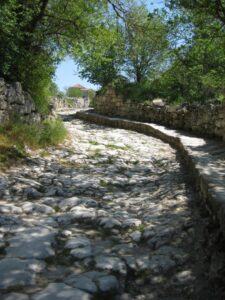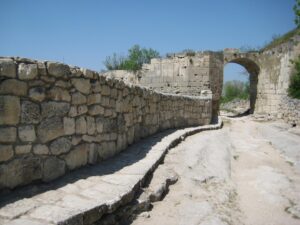© Photos and Text by Okay Deprem http://www.northtravel.org/
A book by the famous historian Arthur Koestler was published in 1976, which created great controversy. The title of the work is “The Thirteenth Tribe”. Koestler, who is also a Jew, in his theory, claims that Eastern, Northern, and Central European Jews (Ashkenazi) originated in a separate, distinct tribe which gave its name to the book in question.
In addition to the twelve tribes, which are also described in the holy book of the Jews and descended from the sons of Jacob, the son of the Prophet Isaac, and each of which will form the Jews of the world; Koestler points to the historical fact that in the Middle Ages, Eastern Europe was dominated by peoples and tribes of Turkic origin. Civilization and state, which the historian author actually implied concretely; seen throughout history; It is none other than the Caspian Empire, which embodies the only society that is ethnically based on Turkic tribes and has adopted the Jewish religion as a belief.
As a result of the barbarian Mongol attacks that shook Eastern Europe as well as the entire Eurasian continental area, immigrating to today’s Hungary and dispersing to more western countries, especially Poland, over time, they started to use the languages of the societies and regions they settled and formed the Jewish communities known as “Ashkenazi”. The historian Koestler claimed that the main tribe from which the Kabars (Kavars) emerged was the Khazars.
Khazar state and Karaites (Karaims)
The Khazar state, shortly after the migration of the first tribes, from the 7th century AD up to 10-11 th century AD was ruled in an area that spread over a very wide geography in the entire north, northwest and north-east of the Caspian Sea and today covers a substantial part of the lands of Ukraine, Kazakhstan and Caucasus countries, especially the Russian Federation.
The Turkic-Jewish Karaites, who remained from the Khazars, as a result of the invasions of the Mongol-Tatar herds, who were the leading of the barbarian tribes that played the role of force in the development dynamics of civilization in the negative sense in history which would disappear into history, and which have survived until our time, were the Turkic-Jewish tribes.




According to a strong and realistic theory, the tribe of the Karai sect of Judaism, who was exiled from the Byzantine Empire to the Khazar State in the 10th century, was settled in the Crimean Peninsula, which was once within the borders of the Caspian country. The Karaite sect, which started to spread rapidly among the Turkic peoples living in the Crimea with the Khazar Khan’s acceptance of the Jewish religion, led to the Turkish people who accepted it in time, also called Karaim.
Today, Karaites (Karaims) and their living traces in Crimea
In our time, the Jewish Turkish community, which has spread from Belarus to Lithuania and Ukraine, from Poland to Romania and Russia, from Dagestan to Turkey, Israel and even the USA, is one of the nearby geographies where live and concrete traces of the Karaites can still be traced is the autonomous republic of Crimea in Russia.


To see two basic settlements, one of which is still alive today, with the traces left behind by the descendants of the Karaims, whose numbers have decreased to several thousand when calculated together with the community in Lithuania, that is, the descendants of the first and probably the last Jewish Turkish state that went down in history a thousand-odd years ago, my way goes to Crimea again.
Bektashi Lodge on the way to Çufutkale
After a long break on a warm and sunny spring day, when the last days of April are experienced and the trees are surrounded by an extraordinary riot of colors with colorful flowers, I am again on my way to the town of Bahçesaray, which is only 45 minutes by road from Simferopol, the capital city of Republic of Crimea in Russia.




This time, I am here to visit the other important civilizational heritage of Bahçesaray, which is mainly known for the Hansaray, the famous palaces of the Crimean Tatars. After driving a few kilometers further in the narrow and green valley that starts after the Palace of the Khans, I get off the taxi at the beginning of the upward climbing point, at the same time at the end of the road. Above, I am already beginning to see some structures and settlements carved into the steep cliffs that adorn the ridges of one side of the valley.
While I am walking through dense vegetation and forested area, a sign that I never expected appears on my way: “Dervish Lodge: Hacı Mansur – 15th Century” Before the Sunni interpretation of Islam dominated the Ottoman Empire, when the general population was Alevi-Bektashi, the Ottomans conquered the new Bektashis, who were considered the most moderate interpreters of religion, were settled in strategic regions in groups in order to assimilate the local population in the places more easily. Considering the year 1475, when Crimea was captured, there is no doubt that this place is the burial ground of the descendants of Bektashis who came to the region for the same purpose and settled there.




Çufutkale as a medieval cave-castle city
Çufutkale, a medieval castle, or rather a castle-city, which was built by the Caspian Turks in the 8th century and later settled mainly by the Jewish Karay Turks (Karatays) and lived until the 19th century, is derived from the addition of the word “kale” to “Çufut”, which is derived from the Turkish word “couple” occurs etymologically.
Just like in the city of Troy, Çufutkale, which houses layers of settlements from different ages on top of each other, is also called a “cave city” because it reflects the predominant settlement type in its early periods. The city, also known as the “Jewish Castle”, will be conquered by the Tatar-Mongol state in the Altun Horde (Golden Army) from the end of the 13th century and the Tatars will reside here until they settle in the Bahçesaray Plain a little below.




After you reach the top and come to the entrance of Çufutkale, a large fortification wall and a magnificent metal gate greet you. The first stop in the castle-city, which covers an area of tens of hectares with the rock houses where the settlement was built in the earliest periods of the Khazars and almost exactly like the ones in Cappadocia.
Then it’s time to see the Karaims’ synagogues, which they call “Kenasa”. These stone structures, one of which is large and the other small, were built successively in the 14th and 18th centuries and survived until today as partially restored; They have a very original architecture with 2 floors, tiled roof, surrounded by mini porticos, one of which is wooden and the other is made of stone and marble columns and columns.



After leaving behind the temples where Hebrew inscriptions and pedestals can be easily read at different points of the courtyard and building facades, this time the stature and infrastructure of the stone-paved main streets and streets of the city is enough to amaze yourself. While high stone pavements decorate the sides of the streets surrounded by building and courtyard walls on the left and right, one or two rows of parallel deep water channels flow in the middle of the roads.
After leaving behind the cells where the monks lived, catacombs, temples, some agricultural structures and the chambers where the ordeal rooms are located, the remains of a mosque appear. These are the ruins remaining from the Canıbek Han Mosque, which was built in 1340 by the Altun Orda Han Canıbek Han, who came to power after the Özbek Han. The tomb built in 1437 for Hanike Hanım, the daughter of Toktamış, another well-known inn of the Golden Horde.





After seeing the tomb built of cut stone, resembling a Seljuk style architecture, I last visit the magnificent defensive walls, fortified places and monumental gates of the castle.
Çufutkale started to be abandoned since the end of the 19th century and turned into a desolation after 1920. I am leaving the region to see another Caspian projection building, leaving Çufutkale alone with its aura of millennial legends and myths.
“This article was published in the monthly journal ‘Hayat Dergi’.”






















